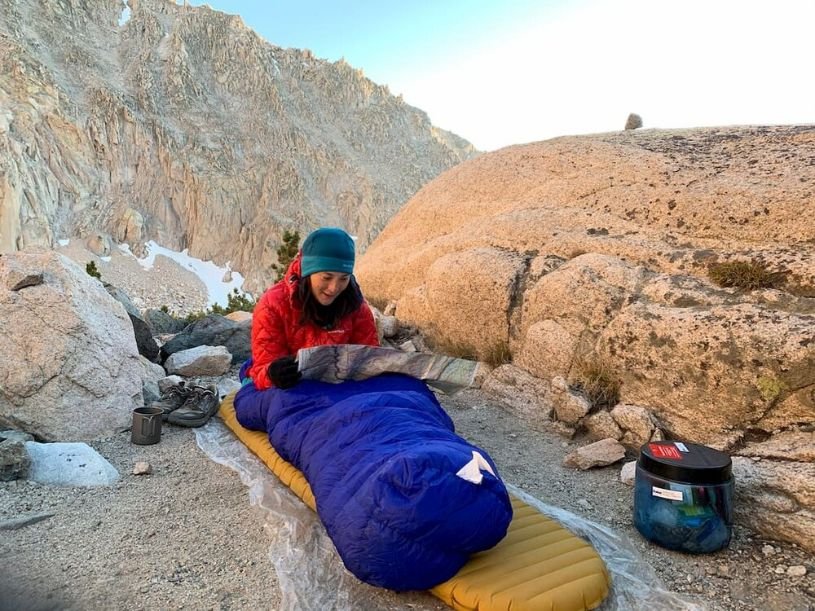Tips for Running in the Rain
Don't let the rain disrupt your running routine!
September 9th, 2023
There’s nothing like getting into the groove of a running routine, only to wake up one morning to the patter of rain against the window.
If you’re like a lot of people, your first instinct is to keep warm and dry under the covers.
It’s understandable–I personally love a cozy, rainy day. But running in rain doesn’t have to be a chore–in fact, it can be a lot of fun.
As someone who grew up in the Midwest and spent nearly two decades training as a competitive racer there, I am all too aware of the joys and pains of running in the rain.
It rains far too often to skip the run each time the clouds darken, so I learned how to be resilient and smart about the practice.
I've learned that with the right running gear and mentality, a rainy run can keep you on your training plan and bring you unexpected joy (or, at least, not be the downer you think it will be).
Here are some tips for running in the rain, and hopefully enjoying it!
We create reader-supported, objective gear reviews independently selected by our editors. This story may contain affiliate links, which help fund our website. When you click on the links to purchase gear, we may get a commission — without costing you an extra cent. Thank you for supporting our work and mission of outdoor coverage for every body! Learn more.
1. Check the forecast
While I’m all about running in the rain, the first tip is to know what you’re getting yourself into and not put yourself in a dangerous situation. If you see a thunderstorm or tornado in the forecast, do not run in it! But if it’s just rain, it’s still good to know how much precipitation to expect, as well as the temperature and wind. If the temps are going to drop, be sure to wear enough clothes to prevent hypothermia. If it’s going to be windy, you may want to opt for a waterproof or water-resistant windbreaker. Check out our guides to the Best Men’s Running Jackets and Best Women’s Running Jackets.
2. Consider your route choices
With precipitation in the forecast, you’ll want to make wise choices when it comes to your running route. Often during rainy weather the sky grows darker, so you’ll want to run somewhere well-lit. It may also be worth your while to run in reflective gear, depending on the time of day. You may also want to run with a light, like one we suggest in our Best Running Lights guide or Best (and Brightest) Headlamps guide.
Additionally, if there’s a chance the weather could take a turn for the worse, you’ll want to run close to your home or your vehicle. Small loops may not be your preferred route, but being close to shelter during heavy winds or unexpected lightning is a smart move for your safety. This became a practice of my training groups when tornado or severe storm watches were in effect (of course, be careful and always err on the side of caution during watches or warnings).
3. Change your mindset
Rather than ruminate on the reality you’re going to be sopping wet by the end of your run, try to focus on the positives. Think of how great you’re going to feel having accomplished your run during less than ideal circumstances. Remember the joy you felt as a kid stomping in puddles. Channel your inner Des Linden during the 2018 Boston Marathon–toughing it out like an absolute boss and winning the race during the worst racing conditions in recent history. (If you’re unfamiliar, check out this video of her finishing that race–I watch it every few months just to feel something.)
And in the wise words of Derek Zoolander, “moisture is the essence of wetness, and wetness is the essence of beauty.” Running in the rain is almost never as bad as you think it's going to be. Embrace it!
4. Be aware of slippery surfaces
With precipitation comes slick surfaces. Be cautious of wet surfaces during your run, especially in potentially freezing conditions and when switching from one terrain to the next, such as from a dirt trail to a sleek cement sidewalk. Road runners will want to be cautious of painted sections of roads, as they tend to be more slick, whereas trail runners will want to be particularly conscientious of flooded or super mucky or muddy trails.
Running poles, like the ultralight Gossamer Gear LT5 Three Piece Carbon Trekking Poles or the foldable Black Diamond FLZ Trekking Poles, may be a good idea for trail runners in the rain, as they can help you steady yourself if you’re slipping on the trail. You can read more about our favorite trekking poles in our Best Trekking Poles guide.
If you’re alternating between surfaces–say, starting on the roads and switching to trails–we love crossover trail running shoes like the Brooks Cascadia 16 and the Hoka Challenger 7 for their traction and comfort on both roads and trails. They both were winners for best crossover shoes in our best women's trail running shoes and best men's trail running shoes guides. You can also read about the Hoka Challenger 7 in our in-depth review.
5. Adjust your pace on wet terrain
It’s ok–really, it’s ok–to slow down when conditions are not ideal. I was a competitive runner and coach for collectively over two decades, and I can assure you it’s fine for your pace to adjust to the conditions. You won’t lose your fitness if your maintenance pace dips a bit every once in a while (in fact, depending on a variety of factors, it could even be beneficial). If you don’t quite hit your workout pace while you’re blasted with wind and heavy rain that’s ok, because fitness can still be gained through the effort at that point. Besides, your health and safety is the top priority–it’s not worth an injury just to run 10 seconds faster/mile.
Here’s an anecdote that may make you feel better about adjusting your pace. My last semester of college I spent all day at a demanding internship. This meant running most of my workouts at 5am–in the dark and often on wet or icy running paths–with no training partners. I almost never hit my goal times, especially when the ground was slick. Nevertheless, that season I ran my best ever 10k time and briefly held the school record. This isn’t to brag–in fact, much of my season was disappointing due to a variety of other factors–but the point is, fitness is built over time. You won’t lose it all by adjusting for the elements as needed.
6. Adjust your running form
Most likely, your body will naturally adapt to the rainy conditions. That is to say, if it’s slick or windy, your muscles will tense or adjust to keep balance. This is also why it’s important to cut yourself some slack regarding pace–your body may be working harder to keep you on track if conditions are rough enough. And if this is the case, you may need to incorporate more recovery strategies post wet run, like foam rolling, elevating your legs, and resting.
7. Run against traffic for visibility
If you’re running on the roads, you should always be running against traffic (unless, of course, there are specific pedestrian lanes to run in). This is increasingly important as visibility decreases. Drivers have a harder time seeing in the dark or rain, so keep that in mind. Wearing reflective gear also helps, which we go into more depth about in our Best Reflective Gear for Running in the Dark guide.
Related: Read our guide to Best Running Lights of 2025 — including headlamps, handhelds, wearables and more!
8. Look for puddles, clogged storm drains, and other obstacles
Be on alert for rain-induced obstacles, like deep puddles, sheets of ice (if it’s near freezing), or anything that rain picks up and carries along where you are running that could turn it into a slippery surface.
9. Bring a rain jacket
A rain shell comes in clutch for keeping you dry and comfy (as comfy as running in the rain can be) while you run. We love the Janji Rainrunner, as well as the Arc’Teryx Norvan LT Hoody if you can swing the price. When it comes to rain jackets, you’ll find some are marketed as running-specific jackets. That’s because running rain jackets offer more ventilation and are generally more lightweight and less cumbersome, to make for easier movements and better breathability.
10. Dress in layers
Dressing in layers will help you stay dry and warm during a rainy day run. In particular, choose clothing that is made of moisture-wicking material, like polyester and nylon. You'll also want a waterproof jacket or water-resistant outer layer (or two).
Keep in mind, a waterproof running jacket will be less breathable than a water-resistant jacket, so if it’s hot out and you don’t mind getting a little wet, the water-resistant jacket may actually be the way to go, especially in light or moderate rain.
Check out our What to Wear Running in the Rain guide for more guidance on dressing for the weather.
11. Wear brightly colored or reflective clothing
Since rain clouds tend to darken the sky, wearing hi-vis or reflective clothing can help you stay more visible to traffic or other pedestrians. This is for your safety, as well as the safety of others. For tips on running in the dark, read Best Reflective Gear for Running in the Dark.
12. Don't wear cotton
Cotton absorbs and holds onto moisture, making your clothing heavier and leaving you more susceptible to blisters, chafing, and hypothermia if it’s cold. Stick to moisture-wicking materials, like polyester and nylon, to make your run in the rain more comfortable and safe. This is also true for your running socks.
13. Wear a brimmed hat
A brimmed hat not only protects your head, but a wide brim helps keep rain off your face. This helps with your visibility, as well as your comfort as you run.
14. Wear a flashing headlamp (even during the day)
Rain clouds make everything darker, which means decreased visibility–both for you and for those operating vehicles. A headlamp, especially one with a flashing tail light, helps you see your route better, and alerts drivers to your presence. Our top pick headlamp for running, the Biolite 800, has a light in the front and in the back for extra visibility. Check out our guide to the Best Headlamps to learn more.
15. Avoid chafing
Wet clothes and skin just love to chafe. The friction irritates the skin as it rubs–skin on skin, skin on wet clothes and wet shoes–causing burning red patches. You can avoid chafing by applying vaseline or a product like Body Glide. That will add a layer of protection and prevent so much irritation. This method also applies to hot days when you sweat more.
16. Choose the right running shoes
You don’t need waterproof running shoes to run in the rain. In fact, most runners prefer not to because non-waterproof shoes are more breathable, and allow water to exit the shoes. However, you will want to make sure your running shoes have enough traction. If the tread on the bottom of your shoes is worn down too much, it may be time for a new pair of running shoes. This is always the case, but especially when dealing with slick surfaces. Additionally, you can consider wearing reflective running shoes. This is by no means necessary–you’re better off investing in reflecting clothing garments that are more visible to drivers. However, running shoes like the Brooks Ghost do offer a hi-vis, reflective option (select the color “Black/Nightlife/Spa Blue”) if you prefer.
17. Protect your phone
If you’re running in the rain with your phone–or any non-waterproof electronic device–remember to keep it safe. I often put my phone in a plastic baggy and/or keep it safe in a fully waterproof pocket.
18. Know the waterproof rating of your watch
Anymore, most running watches are water resistant up to the equivalent of certain depths of water, a feature important to triathletes in particular. For example, the Garmin fenix 7–which we reviewed here–is rated to 10 ATM water resistance, which means it can withstand pressures equivalent to a depth of 100 meters. It should have no problem in the rain. It can even send you alerts about upcoming weather and changes in barometer readings.
You don't have to spent a lot on a waterproof running watch. The more affordable Garmin Instinct, which we review here, is also rated to 100 m.
The Garmin Forerunner 55–which we also reviewed–is an even more affordable running-specific watch, and able to withstand pressures equivalent to 50 meters deep.
19. Know the waterproof rating of your headphones
Make sure your headphones are able to safely withstand the precipitation. The IPXX rating on headphones indicates the intrusion and moisture protection they offer. To learn more about how headphones fare in the rain, we break down IPXX ratings and which headphones offer the best protection, such as the Shokz OpenRun headphones, in our Best Bluetooth Earbuds and Headphones guide.
20. Stay hydrated
Just because water is falling on your skin, doesn’t mean you need to intake any less fluids than usual. Be sure to continue drinking water and electrolytes even in wet weather. For tips on staying hydrated while you run, we have a guide specifically called Tips for Staying Hydrated During Your Runs.
21. Dry your running shoes and wet clothing after your run
Sometimes the relief of ending a rainy run causes us to focus our attention on drying ourselves, showering, recovering, and carrying on with our days. This is important, but your future self will thank you if you also remember to dry your running shoes, clothes, and running socks. A crumpled pile of wet clothes will take a long time to dry and will smell pretty gnarly after a while. And when you head off on your next run, wet shoes are not fun to slip on dry feet. Wet feet will make you more susceptible to blisters, and frankly you may lose motivation to run.
Stick newspaper in each running shoe to soak some of that moisture (this trick also works if you’ve been sweating a lot), and lay or hang your clothes and socks somewhere flat.
22. Put on dry clothes
It may sound obvious, but putting on dry clothes and socks as soon as possible after a rainy run will make you happier, and will encourage the recovery process. When your body is wet, and you’re wearing wet and heavy clothing, your muscles are less inclined to relax, and staying tense and stiff will make it more difficult to recover.
It’s fair to say this rule of thumb applies to sweaty runs, too. In fact, Olympic distance runner, author, filmmaker, and Jill of all trades Alexi Pappas famously encourages sports bra wearers to remove them first thing after a run.
23. If you're cold when you get home, take a hot shower
If your rainy run was also a cold one, it’s important to warm up your body temperature after the run with a hot shower if you can manage it. Cold muscles are more inclined to tighten up, delaying your recovery process and making you more at risk for injuries. You could also drink a warm beverage to warm up–I personally love hot watermelon Nuun (don’t knock it ‘til you try it).
24. Don't forget to warm up and cool down
As always, it’s a smart idea to bookend your runs with a warmup and cooldown to keep your muscles from tightening up too much during or after your run. Active stretching routines, walks, lighter jogging, and foam rolling massages are a few ideas for taking care of your body before and after runs.
25. Do hydration and electrolytes still matter when running in the rain?
Yes! Hydration and electrolytes always matter, regardless of the level of precipitation. According to Patricia Roth with the Michigan State University Extension, “Despite what many may think, our hydration needs do not actually change with the seasons. In cold weather, our bodies lose water the same way they do in the summer, through sweating, breathing and urinating.” It’s easy to not notice how much you’re sweating when your body is wet from precipitation, so it’s important to attend to your hydration needs. To learn more about why it’s important, and strategies for staying hydrated, check out our Tips for Staying Hydrating During Your Runs and Hydration Tips for Trail Runners guides.
About the Author / Why You Should Trust Us
Becca spent nearly three decades in the Midwest, about 18 years of which was spent as a competitive runner. As anyone who runs or lives or visits or even avoids the Midwest knows, you simply cannot avoid running in the rain–and all its temperaments–while training competitively. From joyful sprinkles, to misty mornings, to torrential downpours, and to ill-advised severe weather runs, Becca has trained through it all. Today, as a more laid-back runner in Colorado, she feels giddy when those afternoon rain storms roll in, and wants to help others find that same joy (and safety!) in rainy runs.
Additionally, Becca ran D1 cross country and track for Indiana University—Purdue University of Indianapolis (IUPUI) and continued racing everything from elite miles to an ultramarathon in her post-collegiate years. She earned a USATF Level 1 certification as a running coach and coached boys and girls high school cross country and track in Indianapolis for four years. Becca then joined the IUPUI women’s distance coaching staff as a volunteer assistant coach in 2020-2021. She geeks out on trail running, track and field, and cries every time she watches a marathon (they’re just so beautiful!). After notching a few small FKTs under her belt in 2020, she was diagnosed with hip arthritis and now channels her passion for running into coaching, writing, creating training plans for her friends, hiking, and running when her hip allows it.












